It’s Assassin Time
March 16, 2009 – Last week, the folks handling PR for Wanted: Weapons of Fate flew a bunch of video game reviewers to Hollywood, wined, dined, and lodged them, and gave them access to the game and developers. Here’s what we learned about the third-person shooter, due March 24.
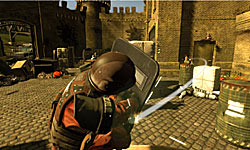
When it comes down to the absolute basics, Wanted is a lot like Gears of War. You’ll be taking cover and moving between protective barriers, trying not to spend much time out in the open. There’s regenerating health, a huge damage difference between headshots and bullets to the body, and a generous checkpoint system that keeps you from having to play the same long sections over and over.
However, it’s unfair to dismiss Wanted as a “Gears clone,” because the developers took this setup and turned it on its head. In Gears, cover is always defensive: you hide, pop up, shoot until the coast is clear, and proceed to the next barrier. In Wanted, cover can also be offensive; by firing a few suppressing shots, you can slow down time. Then, by moving quickly from barrier to barrier (“chaining cover”), you can sneak up on enemies without them seeing you. If you get near enough, a single button press will execute a close-combat kill. The cover-chaining mechanic, coupled with speedier cover-to-cover movement in general, drastically changes the pace and feel of the game.
There are other interesting features as well. The ability to curve bullets will delight fans of the movie; you can shoot hiding enemies by holding down a bumper button and setting a trajectory with a joystick. Also, instead of chaining cover, you can leap between barriers in Max Payne-style slow-mo (“Assassin Time”), killing multiple enemies in the course of one jump. Both of these mechanics cost you “adrenaline,” which is earned by killing enemies (even when you spend adrenaline to do so, meaning that if you kill enough enemies each time you use adrenaline, you hardly ever have to battle your opponents the “normal” way).
Another departure from the Gears formula is the inclusion of Resident Evil 4-esque quick-time events in some of the cutscenes. You’ll retain control of your gun, though, shooting bullets out of the air and killing enemies before they can take you down.
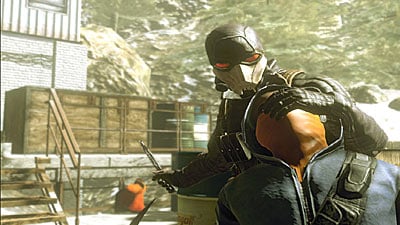
Story-wise, the game picks up where the movie left off, rather than re-making the film or throwing the plot away completely. It’s hard to say much about the game’s events without spoiling the movie’s ending, so we’ll just point out that another branch of The Fraternity (the French one) plays a major role. The events unfold over the course of an eight-to-ten-hour campaign playable in two difficulties at first. (A third unlocks when you finish the game. You can also unlock playable characters and art.)
The notion of The Fraternity existing outside the Chicago branch is something that didn’t come up much in the film; it’s a concept that’s explored more in the hyper-violent comic books on which the movie was based. Weapons of Fate also dresses protagonist Wesley Gibson in his trademark black suit, in addition to the street clothes he wore for the film. The graphic novel’s author, Mark Millar, gave the developers advice on the game.
However, the main inspiration here is the motion picture, not the comic. The graphics aim for photorealism, not a cel-shaded comic look, and some of the character models and voice acting come from the movie’s cast. A few of the levels even recreate scenes from the film (the airplane sequence evokes the train scene from the movie).
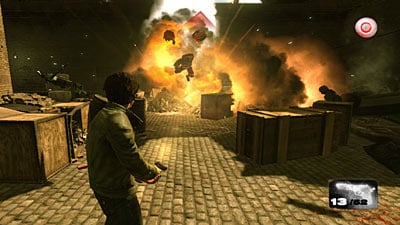
Movie-based games start with two strikes against them, but judging by the publisher’s behavior and our interactions with the staff, this is a game that’s been taken seriously. Perhaps most compelling is the fact that though development started back in early 2007, management didn’t insist that the game’s release coincide with that of the movie (June 2008) or the DVD (December 2008). This indicates not only that it was important to Universal Studios that GRIN be given enough time, but also that Universal is confident that the game can succeed without riding the movie’s publicity coattails. Further, the developers avoided tacking on features they couldn’t fully flesh out, even if said features would look good on the back of the box. They won’t hesitate to tell you they decided to go without multiplayer and don’t regret it, for example.
Of course, the best way to test the effort put into a title is to play it, and at the Wanted event, we got to spend some hands-on time with the final code. We’ll save our standard list of good and iffy attributes for the release-day review, but for now, suffice it to say that the gameplay innovations work very, very well. As a masked, fleet-footed assassin should, you feel incredibly mobile, strategically darting around each battlefield inflicting death on anyone unfortunate enough to get in your line of sight (or warped shooting trajectory). The controls are intuitive, thanks to the developers’ following Gears’ lead on the basics and extensively testing the new mechanics (in an early build, they say, you could steer the bullets directly, but that felt too clumsy).
Our experience with Wanted left us convinced it’s not your typical movie game. “Great, but is it actually worth $60?” you might say. Good point. Check back March 24 to read our full review, and to see if you should plunk your hard-earned cash on this title.
Game Features:
Assassins…
Can’t Live with ‘em…
January 5, 2009 – Wanted, the big screen adaption of the Mark Millar and J.G. Jones comic series, was a huge success at the summer box office. Playing alongside what is (in my opinion) the greatest comic book adaptation ever, The Dark Knight, it managed to make a very respectable $93 million dollars. Impressive enough to warrant a video game adaptation I suppose, but there were two words that made Wanted: Weapons of Fate a must for gamers: Bullet-bending. Once gamers and comic fans saw the flashy exploits of Wesley and the Fraternity it was love at first sight.
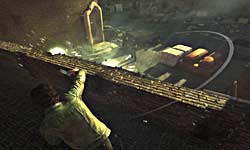
Lucky for shoot-out fans everywhere, developer GRIN and publisher Universal Studios will be playing matchmaker when Wanted: Weapons of Fate hits consoles in 2009. Taking a cue from other successful movie tie-ins, including its own Scarface: The World is Yours, Universal has taken pains to craft an experience the fans of the film will enjoy, but won’t retell the same story. By combining the onscreen adventures of Wesley and company with the Image Comic escapades of our favorite assassins, the idea is to create a story that captures the spirit of the film and expands on the comic origins of the story.
Picking up only hours after the events of the film, Weapons of Fate will follow Wesley as he attempts to discover the secrets of the Fraternity and find out more about Cross and the fate of his mother. Players will visit several locals from the film (though probably at different time periods and in different situations) and gamers will have the opportunity to play as both Cross and Wesley. Other characters have been hinted at, but there’s no official word on them or multiplayer yet.
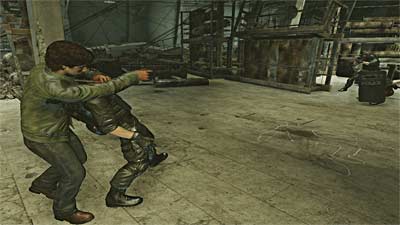
Weapons of Fate runs on the same engine as the forthcoming Bionic Commando, which seems to have influenced visuals more than gameplay. Graphically, Weapons of Fate is solid if not overly impressive. Muzzle flashes and explosions yield impressive flairs and sparks, while Wesley himself sports some nice textures, particularly on his signature leather jacket. In-action gunplay is definitely the showpiece of the Weapons of Fate art department. Whether moving from cover to cover, stabbing a soldier in the privates, or sliding across a desktop and popping a guy from across the room, movement, gunplay, and close quarters combat all look phenomenal. Even from the trailer, it’s clear that fluidity and moments of downright jaw dropping visual displays were on the forefront of the developers minds. Of course, it’s difficult to say before the release of the game, but watching Wesley slide across the overturned shelves, like a scene from The Dukes of Hazzard, is undeniably cool. It’s clear that the visuals from the film had a huge impact on the development team.
Predictably, though it’s not necessarily a bad thing, most of the action of Weapons of Fate centers around run and gun action broken up by close quick-time, Resident Evil 4-style kills. Players will chain cover to cover movements to build up an adrenaline meter. Once filled, this meter allows players to pull off special moves including the trademark bullet-bending. Holding down the trigger, a bullet curve overlay will appear on screen displaying the trajectory of your shot. Players then finesse the arc of the shot until the curve turns white (from red) and then release the trigger to blast enemies behind cover.
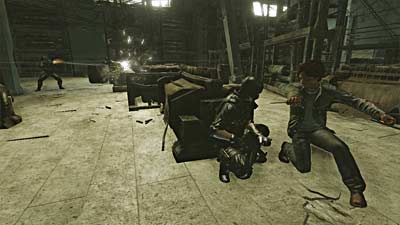
It’s an interesting mechanic and seems to go a long way towards adding a new twist to the cover-fire-advance formula refined by other third-person shooters (most popularly by Gears of War). While bending bullets around riot shields and hallway corners is cool, even the best marksmen need some hand to hand moves these days (what with the rising prices of bullets) and Wesley’s won’t disappoint. As anyone who saw the film knows, he’s actually pretty handy with a combat knife, and any enemy who manages to get close enough will be treated to a quick trip to that big textile mill in the sky courtesy of Wesley’s handiwork. These one button quick-time kills are easily executed, slick, quick, and bloody. It’s impressive stuff.
Weapons of Fate will release in the first quarter 2009. Like so many curved bullets, GRIN, gamers, and comic fans alike hope awesome gameplay is just around the corner.
Game Features:
